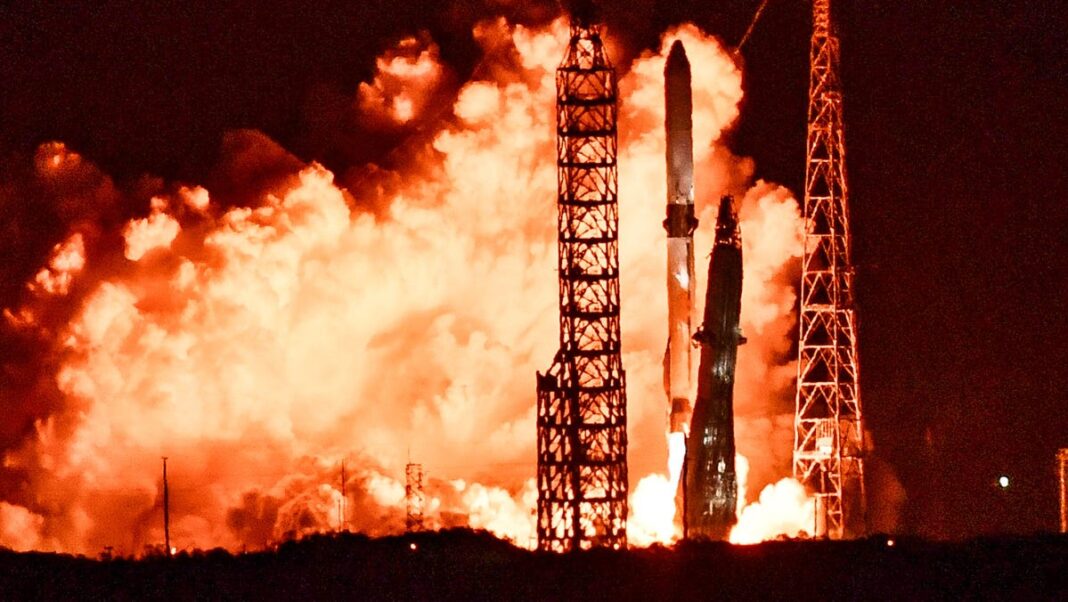Jeff Bezos’ Blue Origin Launches New Glenn Rocket: Key Details on SpaceX’s Competitor
This rocket marks Blue Origin’s first development aimed at carrying satellites, equipment, and potentially humans into orbit for paying clients.
A large rocket from Blue Origin, created to compete with SpaceX in launching satellites and other payloads into space, successfully completed its first flight test early Thursday morning from Cape Canaveral, Florida.
The New Glenn rocket, a project from Jeff Bezos’ space technology company, was transported to the launch pad days before its initial flight. The launch faced multiple delays due to adverse weather and technical difficulties, but Blue Origin managed to proceed before dawn.
This rocket is Blue Origin’s first designed specifically for sending satellites, equipment, and potentially crewed missions for customers who pay.
By offering these services, Blue Origin aims to rival SpaceX’s stronghold in the commercial space sector, especially notable for its extensive fleet of Starlink satellites that provide internet access globally.
New Glenn Rocket Launches From Florida
The New Glenn rocket lifted off at 2:03 a.m. EST from Complex 36 at Cape Canaveral Space Force Station, according to updates from Blue Origin.
The launch complex, which Blue Origin invested $1 billion to renovate, is located just nine miles from the manufacturing site of the rocket.
The uncrewed flight’s main goal was to ensure that the rocket’s second stage reached orbit successfully before attempting to land the booster (the first stage) on a barge in the Atlantic, hundreds of miles away.
While the second stage achieved orbit and operated effectively, Blue Origin later reported that the booster did not make a successful landing during its descent. Landing the booster on the first try was acknowledged as “an ambitious goal,” as stated by Blue Origin CEO Dave Limp.
“I’m incredibly proud that New Glenn reached orbit on its initial attempt,” Limp said. “We’ll gain valuable insights from this and aim to improve with our next launch this spring.”
The rocket had aimed for a launch as early as January 10, but weather conditions in the Atlantic forced a delay.
Subsequent attempts faced hurdles, including ice buildup in key pipes found on the rocket during a Monday launch attempt and poor weather on a Tuesday attempt.
Understanding the New Glenn
Named in honor of John Glenn, the first American to orbit the Earth, New Glenn is a heavy-lift launch vehicle stretching 320 feet, competing directly with SpaceX’s 400-foot Starship. Its first stage, operated by seven BE-4 engines, is engineered to be reused for up to 25 missions.
During its first flight, New Glenn carried cargo associated with Blue Ring, the company’s multi-purpose orbital platform. This test payload remained with the rocket’s second stage throughout the six-hour mission.
“Blue Ring is essential for paving the way to space; this mission is a vital beginning for Blue Ring that will facilitate more dynamic and responsive operations beneficial to our nation,” said Paul Ebertz, a senior vice president with Blue Origin’s in-space systems, in a statement.
Blue Origin Aims to Compete with SpaceX
Blue Origin’s New Glenn launch signifies the company’s ambition to become a prominent competitor in the commercial space sector, going head-to-head with Elon Musk’s SpaceX.
SpaceX’s Falcon 9 rocket, known for its reusability, has garnered a reputation as one of the most frequently used rockets globally, making it a top choice for NASA and various private companies sending vessels into space. Additionally, SpaceX has launched over 6,000 operational Starlink satellites into orbit since 2019.
Executives at Blue Origin expressed that Thursday’s launch brings New Glenn closer to transporting Project Kuiper satellites into orbit and taking on other missions for paying clients, such as NASA and telecommunications firms.
While SpaceX continues to work on its large Starship for human missions, Blue Origin indicated that New Glenn is also intended to support upcoming NASA lunar missions as part of the Artemis program.
“Today heralds a new era for Blue Origin and the commercial space sector,” stated Jarrett Jones, a senior vice president at Blue Origin overseeing New Glenn. “We’re dedicated to increasing our launch frequency and production capacities.”
New Shephard: Blue Origin’s Other Venture
Alongside New Glenn, Blue Origin’s smaller rocket, New Shephard, is also engaged in regular flights.
In October 2024, Blue Origin successfully launched and landed an uncrewed flight test of its next New Shepard spacecraft, which is designed for future suborbital trips for humans above Earth.
The launch from Texas marked the first mission of Blue Origin’s NS-27, the second New Shepard rocket intended for passengers. Although no humans were aboard this test flight, eight out of the 26 missions flown by Blue Origin so far have included crew members, including Jeff Bezos himself.
Eric Lagatta provides coverage on breaking and trending news.

